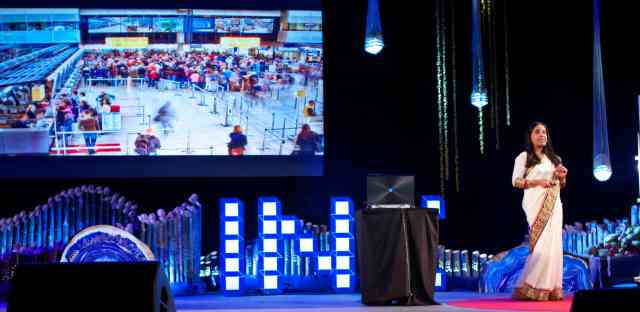Sitting in science class as a child, we learned about incandescent light bulbs and Thomas Edison, while the tube lights flickered overhead. These fluorescent lights were the future.
Rajeswari Kannan grew up thinking about the energy spectrum and how to use visible light. As a child, she was fascinated with sound and light and how communication occurs with the energy spectrum. She earned a degree in computer engineering and now works at Nokia in Bangalore, India. She hopped over to Kochi and the INK2013 conference in late October to share about her en-light-ening projects.
Glass tubing. Some electrodes. Mercury vapor as the main source of luminescence. Argon, xenon, neon, krypton, the inert gases for filling those glass tubes. And fluorescent coatings that can be energized by ultraviolet light.
Fluorescent lights function by first creating a non-visible ultraviolet (U-V) source light at 253.7nm generated by energizing the mercury vapour inside a long glass tube. This source light is then bounced off heavy metals and trace elements called phosphors which converts them to yellow and blue, and a little green and red.
Together these appear to our eyes as white light. The problem is that when the UV light bounces, it does not bounce evenly, and it creates a flicker pattern that eyes can pick up if they are sensitive.
When video cameras are turned on in the same room, the camera brightness and image flicker. And when we point cellphones at our computer screens, they flicker too.
Our eyes like continuous light, not flickering. Thomas Edison reported that 46 frames per second was the minimum: anything less will strain the eye. So technology has figured out how to make movies, cameras and light appear not to flicker by making the flicker occur at more than 48 frames per second. But they are.
Rajeswari has been developing technology to use this flicker and convert it to a kind of Morse code. Instead of sound clicks, she is using light clicks. She has patented a technology that humanizes the light. “The lights are already flickering at 60kHz; we have simply learned how to send data to it and use it.”
Ayurveda uses light, heat and fire as a central concept in many of its explanations. Prior to WWII, most of the books of Ayurveda would explain the concepts of tejas, agni, usma, and bhaswega in terms of physics, photons, and different ways that living beings convert different components of light into different understanding. Jagadish Chandra Bose’s experiments with sound, light, plants and conversion of light were cited in these books. All of that disappeared as American engineering eclipsed the science in the rest of the world. So I am fascinated to hear Rajeswari chat about her experiments with light.
Kannan heads the Media Technologies Lab at the Nokia Research Center in Bangalore, which focuses on computational imaging research by utilizing existing and novel camera optics, sensors and signal processing techniques to capture and visualize information in new ways.
Her team has programmed standard white fluorescent lights to strobe at a frequency still invisible to the naked eye but highly visible to our cameras and cellphones. The cellphones using their LED flash strobe as a data transmitter take these programmed signals embedded with a binary code similar to what fax machines and computers use to communicate, and convert them to messages it gives us.
She shows two examples of practical use to the modern, urban Indian.
Imagine walking into a train station that is crowded. Instead of searching frantically for the schedule board, which may or may not be working, or is not programmed to update frequently, a person can take out her mobile phone and point it to a fluorescent light in the ceiling that has a ring indicating it is programmed. The phone will read the light using its camera and convert the invisible flickers into a train schedule that is visible on your phone and portable as you through the station.
Going to a cinema complex and trying to decide which film to watch will get a little easier. A person can point his mobile phone to a fluorescent board with the poster of the film. The phone will read the light as long as you keep pointing at it, converting the invisible flickers into the film’s trailor through videostreaming. You can point at each film and watch each trailor before, or after, you decide.
Over 900 million people in India use a mobile phone. This technology of mass communication, imbedding messages into photons, is expected to be seen in public venues shortly.
As for Rajeswari, she also uses light and sound as part of her teaching her 6-year old daughter about the world. She has created signaling and communication games for her using colored light, strobes, and sounds.
 Dr. Bhaswati Bhattacharya is a physician-scientist working in Ayurveda as a Fulbright-Nehru Scholar. Follow her adventures at srotamsi.blogspot.in.
Dr. Bhaswati Bhattacharya is a physician-scientist working in Ayurveda as a Fulbright-Nehru Scholar. Follow her adventures at srotamsi.blogspot.in.


